Have you ever walked through a pine forest and noticed dying or dead trees with wilting, brown needles clinging to their branches? These are the grim faces of Pine Wilt Disease, a fatal disease that is decimating pine forests around the globe. Understanding this disease is our first line of defense, as knowledge is power in this fight.
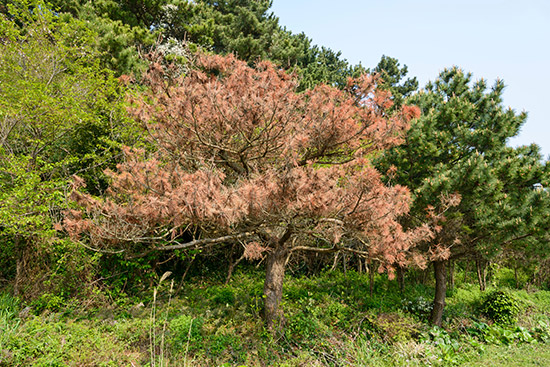
• Pine Wilt Disease is a destructive infection caused by pinewood nematodes and sawyer beetles, especially damaging to non-native pine species.
• Identifying wilting needles, noticing symptoms from July to December, and not planting susceptible species are critical tree care tips for avoiding this fatal tree disease.
• Preventative measures such as removal of infected trees/branches & chemical control with abamectin injections can help manage Pine Wilt Disease. Alternative tree choices should be considered in affected areas.
Pine Wilt Disease, also known as pine wilt infection, arrives uninvited, wreaks havoc, and leaves destruction in its wake, with the assistance of tiny pinewood nematodes and sawyer beetles as its partners in crime. The nematodes infiltrate healthy trees, delivered on the wings of the beetles, ultimately leading to the swift demise of the trees.
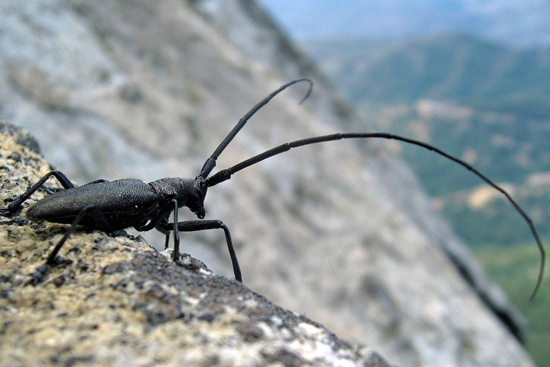 Thomas Schoch, CC BY-SA 3.0, via Wikimedia Commons
Thomas Schoch, CC BY-SA 3.0, via Wikimedia Commons
This disease was first documented in 1934 in the southeastern United States and has since spread westward. It poses a serious threat to pine forests, especially non-native pine species, causing high mortality rates.
Pine wood nematodes, also known as pine wilt nematodes, are microscopic invaders that wage war on pine trees. These tiny roundworms disrupt the transportation of water and nutrients within plant cells, akin to cutting off a city’s water supply, leading to the eventual death of the tree. They cause significant damage to the water-conducting tissues of pine trees, leading to wilting and tree demise.
During their life cycle, these organisms infest mature pine trees and undergo rapid multiplication in warm periods. They spread throughout the tree with the aid of bark beetles and the existence of blue stain fungi.
Sawyer beetles, particularly the pine sawyer beetle, act as vehicles, carrying soldier-like nematodes to new conquests. These pine sawyer beetles transmit pinewood nematodes to healthy trees during feeding and when laying eggs, resulting in the formation of U-shaped tunnels where the larvae develop.
The beetles begin their flight from early July to October, with their peak between late August and mid-September. They prefer trees with bark for laying eggs, and some species can carry substantial nematode loads, making them highly effective vectors.
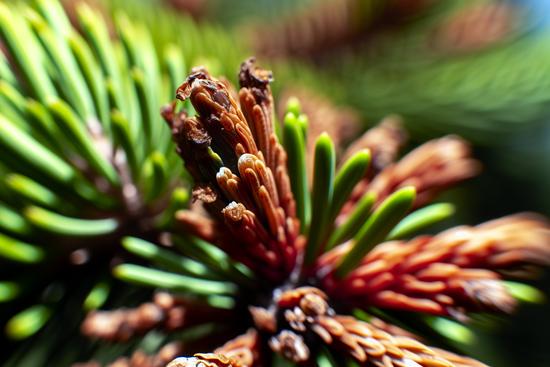
Identifying the symptoms of Pine Wilt Disease equates to understanding a tree’s cry for help. The primary indicators include wilting of the needles, which turn from a lush green to a gray-green or brown color and persist on the tree. The color change in pine needles is a significant symptom of the disease.
If not addressed, the disease advances swiftly within the infected trees, turning the entire tree into a brown, wilting mass within a matter of weeks.
The early symptoms of Pine Wilt Disease can be likened to the calm before the storm. Small holes in the bark and pitch tubes serve as early indicators, suggesting the presence of beetle galleries. These holes are created by female beetles chewing into the bark of recently dead or dying pine trees to deposit eggs. The resulting larvae then feed on the inner bark, leading to the formation of surface galleries.
Pitch tubes are resinous exudations pine trees produce as a defense response to invading beetles. These tubes are closely linked to the formation of beetle galleries under the bark, serving as a tell-tale sign of the impending onslaught. The size of these holes can vary, with more severe infections exhibiting larger exit holes.
The journey of Pine Wilt Disease within a tree is swift and destructive. It starts with the onset of symptoms in July and can continue to develop until December. The wilting process begins at the upper part of the tree and moves down, much like a wave crashing over the tree’s crown and washing over its lower sections.
Pine Wilt Disease can severely impact the health and lifespan of pine trees over ten years old, leading to decreased photosynthesis, interference with resin canal formation, and abnormalities in the xylem and cambium. Affected trees may succumb within a few months, causing significant environmental and economic damage. As the disease progresses, the tree will display noticeable changes, including a shift in leaf color from green to yellow and a gradual yellowing of the needles in the tree’s crown.
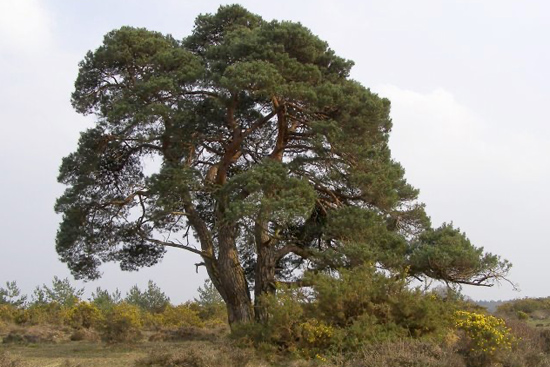 Jim Champion / Spreading Scots pine tree, Redrise, New Forest
Jim Champion / Spreading Scots pine tree, Redrise, New Forest
Though all pine trees are at risk, non-native species predominantly bear the brunt of Pine Wilt Disease, akin to a ship in a tumultuous sea. Some examples of pine trees and their susceptibility to the disease are:
• Scotch (Scots) pines: highly susceptible
• Austrian pines: highly susceptible
• Jack pines: moderately susceptible
• Mugo pines: moderately susceptible
Drought-stressed native pines, on the other hand, are more vulnerable to the disease, much like a shield with its defenses lowered.

Solving the mystery of Pine Wilt Disease diagnosis relies on molecular testing of wood samples or drill shavings as crucial evidence. These samples can be obtained using an impact driver from the main trunk or from drill shavings at breast height from 3-4 sides of the tree if felling the tree is not feasible.
Prior to testing, it is recommended to store tissue samples in the freezer to preserve their integrity.
Prevention of Pine Wilt Disease includes the following measures:
• Removing infected branches and trees
• Providing adequate water and fertilizer
• Avoid planting susceptible species in areas where the disease is present.
Cultural practices provide local wisdom for managing Pine Wilt Disease. Some strategies employed include:
• Removal of symptomatic trees
• Cutting down dead trees and burning or burying the wood
• Removing or burying stumps
• Avoiding planting susceptible species in areas where the disease is present
These practices can help manage Pine Wilt Disease effectively.
Heat-treating unseasoned lumber to a core temperature of 56°C (133°F) for 30 minutes is a method used to kill nematodes present in wood chips or unseasoned lumber. This is akin to sterilizing surgical tools, ensuring the disease doesn’t spread through the lumber.
Chemical control serves as an artillery in the war against Pine Wilt Disease. Preventive injections of abamectin, a naturally occurring fermentation product, are a chemical tree care method used to protect against pine wilt disease.
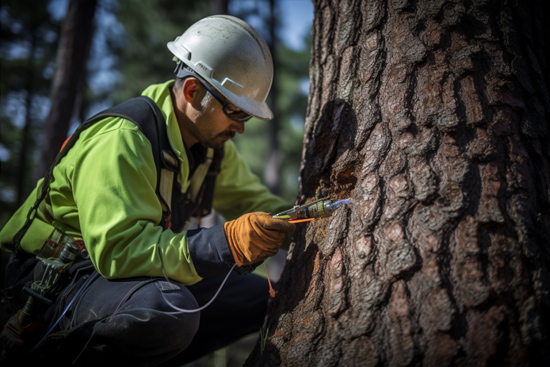
These injections have shown effectiveness in managing the disease, resulting in a threefold increase in the survival rates of trees exposed to the nematodes. However, it’s important to note that the treatment is not effective once symptoms have manifested.
The injections should be evenly distributed across each injection site, and a single treatment protects against nematode infection for up to two growing seasons.
Considering alternative tree choices for areas impacted by Pine Wilt Disease is imperative in its aftermath. Some options for replacement trees include:
• Native pine species
• Eastern white pine
• Jackpine
• Douglas fir
These dying trees, some of which may be infected, can serve as sturdy replacements for a pine tree.
Standing guard over our forests involves monitoring and reporting Pine Wilt Disease. Regularly checking for symptoms, such as wilted, gray-green, or brown needles that remain attached to the tree, decreased resin secretion, and comprehensive yellowing of foliage, is crucial. There are other pine tree diseases, so if a tree is suspected of being infected, consulting a licensed arborist or a Plant Diagnostic Clinic can provide expert advice.
Effectively managing the disease’s spread requires reporting suspected cases.
In the battle against Pine Wilt Disease, understanding the enemy – its causes, symptoms, and prevention measures – is our strongest weapon. We have explored the roles of pinewood nematodes and sawyer beetles in spreading the disease, the symptoms and progression of the disease, the pine species most susceptible to the disease, and how to diagnose and test for the disease. We’ve also delved into the cultural and chemical preventative measures and management strategies, including alternative tree choices and the importance of monitoring and reporting the disease.
To fix pine wilt disease, trees can be protected with trunk injections of abamectin or emamectin benzoate. Unfortunately, once a tree is infected, there is no cure, and diseased trees should be destroyed by burning, chipping, or burying. The stump should be removed or ground down and buried under 6 inches of soil to prevent the spread of the disease.
Unfortunately, trees infected with pine wilt cannot be saved. They must be destroyed by burning or burying them before the pine sawyer beetles can spread the nematodes from the diseased tree to any nearby healthy trees. Diseased wood should not be used as firewood either.
Pine wilt disease symptoms look like pine needle discoloration, which progresses rapidly from grayish-green to yellow and then brown. Wilting and tree death are also common appearances.
Pine Wilt Disease is caused by pinewood nematodes that sawyer beetles spread.
Non-native pine species, such as Scotch and Austrian pines, are most susceptible to Pine Wilt Disease.